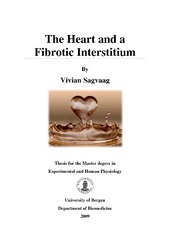| dc.description.abstract | Several acute and chronic diseases disposes for myocardial oedema and fibrosis, leading to impaired cardiac function, presumably as a result of an increased chamber stiffness. Mechanisms and adverse effects of both oedema and fibrosis in the heart have only partly been elucidated; however, the temporal and spatial development is still unknown. Objective: The purpose of our study was to: (1) establish an in vivo pulmonary artery (PA) banded model that produces myocardial oedema and fibrosis in both ventricles, and (2) examine the temporal and spatial development of oedema- and subsequent fibrosis formation in both acute and chronic protocols. Methods: A PA-banded model was utilized to elevate the right ventricular (RV) pressure, to subsequently produce both right- and left sided ventricular myocardial oedema and on a longer time scale, fibrosis, in male Wistar rats. The left ventricular (LV) oedema formed due to the drainage system via sinus venosus and the thebesian veins, further exacerbated by lymphatic congestion, allowed us to study the LV itself without interferences from manipulation. Gravimetric wet to dry weight ratio as an index of total tissue water (TTW) and oedema, and hydroxyproline as an indicator of total collagen synthesis and fibrosis formation, were measured in the RV and LV and the septum. Results: Right ventricular developed pressure (RVDP) was significantly elevated in all PA-banded procedures as compared the initial pressure measurements pre-PA-banding and the corresponding sham values. Contraction (dP/dt maximum) and relaxation (dP/dt minimum) of the RV pressure was increased in both acute and chronic experimental PA-banded groups, while heart rate (HR) remained unchanged. No significant increases in TTW or total collagen content was seen until 17 days post-PA-banding (note: n=1 in each group). Conclusions: Continuously increased RV pressures post-PA-banding demonstrated a marked response to the constriction. The heart seemed to overcome the elevated pressure by increasing cardiac contraction and relaxation (dP/dt). No indication of myocardial oedema or fibrosis formation was seen within the first hour of acute PA-banding. Preliminary data from chronic protocols indicated that myocardial oedema was not developed within 24 hours, but after 17 days post-PA-banding, with subsequent increases in collagen synthesis (note: n=1 in each group). | en_US |
